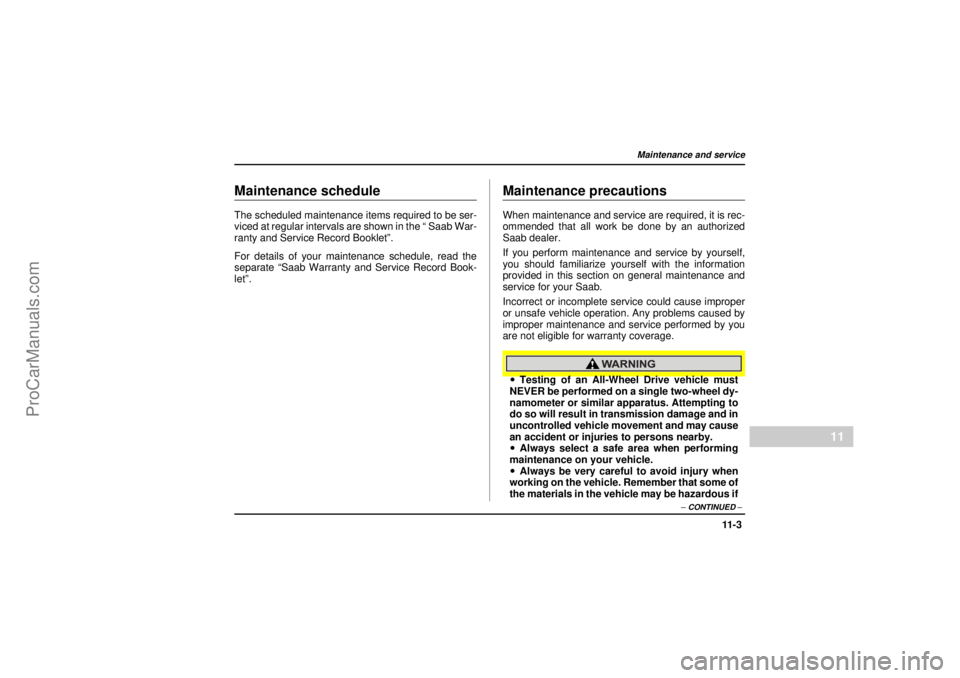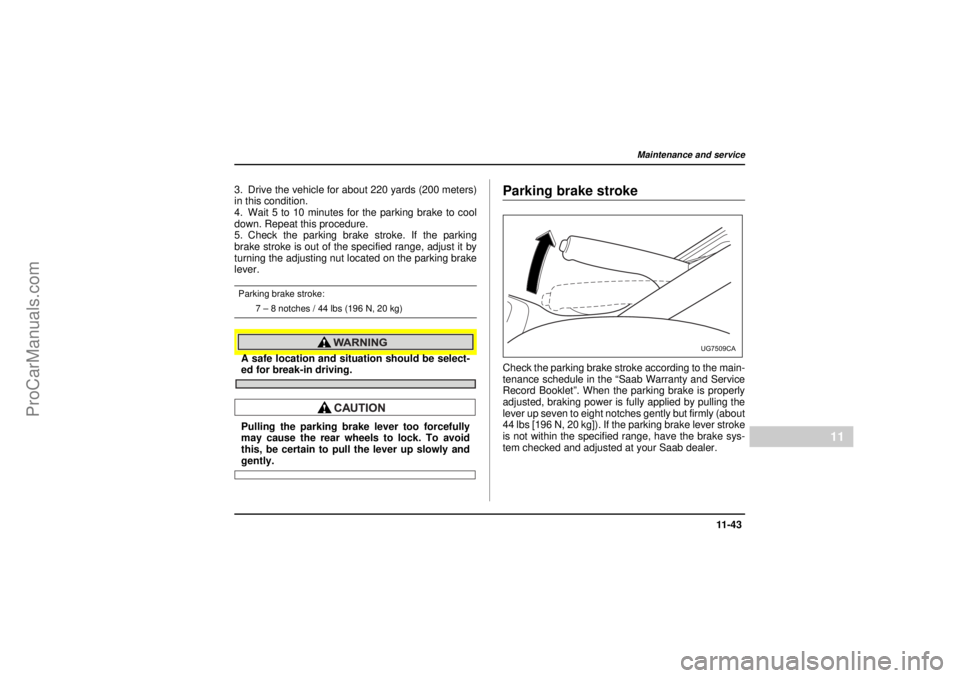2005 SAAB 9-2X service schedule
[x] Cancel search: service schedulePage 328 of 444

11 - 3
Maintenance and service
– CONTINUED –
11
18 February 2004
Maintenance and serviceMaintenance scheduleThe scheduled maintenance items required to be ser-
viced at regular intervals are shown in the “ Saab War-
ranty and Service Record Booklet”.
For details of your maintenance schedule, read the
separate “Saab Warranty and Service Record Book-
let”.
Maintenance precautionsWhen maintenance and service are required, it is rec-
ommended that all work be done by an authorized
Saab dealer.
If you perform maintenance and service by yourself,
you should familiarize yourself with the information
provided in this section on general maintenance and
service for your Saab.
Incorrect or incomplete service could cause improper
or unsafe vehicle operation. Any problems caused by
improper maintenance and service performed by you
are not eligible for warranty coverage.!Testing of an All-Wheel Drive vehicle must
NEVER be performed on a single two-wheel dy-
namometer or similar apparatus. Attempting to
do so will result in transmission damage and in
uncontrolled vehicle movement and may cause
an accident or injuries to persons nearby.
!Always select a safe area when performing
maintenance on your vehicle.
!Always be very careful to avoid injury when
working on the vehicle. Remember that some of
the materials in the vehicle may be hazardous if
ProCarManuals.com
Page 336 of 444

11-11
Maintenance and service
– CONTINUED –
11
18 February 2004
If you check the oil level just after stopping the engine,
wait a few minutes for the oil to drain back into the oil
pan before checking the level.
Just after driving or while the engine is warm, the en-
gine oil level reading may be in a range between the
upper level and the notch mark. This is caused by ther-
mal expansion of the engine oil.
To prevent overfilling the engine oil, do not add any
additional oil above the upper level when the engine is
cold."Changing the oil and oil filterChange the oil and oil filter according to the mainte-
nance schedule in the “Saab Warranty and Service
Record Booklet”.
The engine oil and oil filter must be changed more fre-
quently than listed in the maintenance schedule when
driving on dusty roads, when short trips are frequently
made, or when driving in extremely cold whether.
1. Warm up the engine by letting the engine idle for
about 10 minutes to ease draining the engine oil.
2. Park the vehicle on a level surface and stop the en-
gine.
3. Remove the oil filler cap.
Do not touch the exhaust manifold or turbo-
charger. These get very hot when the enginehas been running.2.0-liter turbo models
UGB105BA
ProCarManuals.com
Page 341 of 444

11 - 1 6Maintenance and service
26 December 2003
"Recommended grade and viscosity
under severe driving conditionsIf the vehicle is used in desert areas, in areas with very
high temperatures, or used for heavy-duty applica-
tions such as towing a trailer, use of oil with the follow-
ing grade and viscosities is recommended.API classification SL (or SJ):
SAE viscosity no.: 30, 40, 10W-50, 20W-40, 20W-50
"Synthetic oilYou can use synthetic engine oil that meets the same
requirements given for conventional engine oil. When
using synthetic oil, you must use oil of the same clas-
sification, viscosity and grade shown in this owner’s
manual, and must follow the oil and filter changing in-
tervals shown in the maintenance schedule.
Cooling systemNever attempt to remove the radiator cap until
the engine has been shut off and has cooled
down completely. Since the coolant is under
pressure, you may suffer serious burns from a
spray of boiling hot coolant when the cap is re-moved.!The cooling system has been filled at the fac-
tory with a high quality, corrosion-inhibiting,
year-around coolant which provides protection
against freezing down to –33°F (–36°C). For
adding, use genuine Saab coolant or an equiv-
alent: a mixture of 50% soft water and 50% eth-
ylene-glycol basis coolant. Use of improper
coolants may result in corrosion in the cooling
system. It is important to maintain protection
against freezing and corrosion, even if freezing
temperatures are not expected. Never mix dif-
ferent kinds of coolant.
!Do not splash the engine coolant over paint-
ProCarManuals.com
Page 343 of 444

11 - 1 8Maintenance and service
18 February 2004
1) Rubber gaskets3. After refilling the reserve tank and the radiator, re-
install the caps and check that the rubber gaskets in-
side the radiator cap are in the proper position.!Be careful not to spill engine coolant when
adding it. If coolant touches the exhaust pipe, it
may cause a bad smell, smoke, and/or a fire.
!Do not splash the engine coolant over paint-
ed parts. The alcohol contained in the enginecoolant may damage the paint surface.!Changing the coolant
1) Drain plugAlways add genuine cooling system conditioner when-
ever the coolant is replaced.
Change the engine coolant and add genuine cooling
system conditioner using the following procedures ac-
cording to the maintenance schedule.
1. Remove the under cover.
2. Place a proper container under the drain plug and
loosen the drain plug.
3. Loosen the radiator cap to drain the coolant from
the radiator. Then drain the coolant from the reserve
tank. Tighten the drain plug securely.
1
HSB026BB
1
HSB027BB
ProCarManuals.com
Page 351 of 444

11 - 2 6Maintenance and service
18 February 2004
Spark plugsIt may be difficult to replace the spark plugs. It is rec-
ommended that you have the spark plugs replaced by
your Saab dealer.
The spark plugs should be replaced according to the
maintenance schedule in the “Saab Warranty and Ser-
vice Record Booklet”.
!When disconnecting the spark plug cables,
always grasp the spark plug cap, not the ca-
bles.
!Make sure the cables are replaced in the cor-rect order."Recommended spark plugs2.5-liter non-turbo models:
FR5AP-11 (NGK)
2.0-liter turbo models:
PFR6G (NGK)
HSB032BA
ProCarManuals.com
Page 365 of 444

11 - 4 0Maintenance and service
18 February 2004
Brake pedalCheck the brake pedal free play and reserve distance
according to the maintenance schedule in the “Saab
Warranty and Service Record Booklet”."Checking the brake pedal free play1) 0.04 – 0.12 in (1.0 – 3.0 mm)Stop the engine and firmly depress the brake pedal
several times. Lightly press the brake pedal down with
one finger to check the free play with a force of less
than 2 lbs (10 N, 1 kg).If the free play is not within proper specification, con-
tact your Saab dealer.
"Checking the brake pedal reserve dis-
tance1) More than 2.56 in (65 mm)Depress the pedal with a force of approximately 66 lbs
(294 N, 30 kg) and measure the distance between the
upper surface of the pedal pad and the floor.
When the measurement is smaller than the specifica-
tion, or when the pedal does not operate smoothly,
contact with your Saab dealer.
1
HSB049BB
1
HSB050BB
ProCarManuals.com
Page 366 of 444

11 -4 1
Maintenance and service
– CONTINUED –
11
18 February 2004
Clutch pedal (MT vehicles)Check the clutch pedal free play and reserve distance
according to the maintenance schedule in the “Saab
9-2X Saab Warranty and Service Record Booklet”."Checking the clutch functionCheck the clutch engagement and disengagement.
1. With the engine idling, check that there are no ab-
normal noises when the clutch pedal is depressed,
and that shifting into 1st or reverse feels smooth.
2. Start the vehicle by releasing the pedal slowly to
check that the engine and transmission smoothly cou-
ple without any sign of slippage.
"Checking the clutch pedal free play1) 0.16 – 0.51 in (4.0 –13.0 mm)Lightly press the clutch pedal down with your finger
until you feel resistance, and check the free play.
If the free play is not within proper specification, con-
tact your Saab dealer.
1
HSB049BB
ProCarManuals.com
Page 368 of 444

11 -4 3
Maintenance and service
– CONTINUED –
11
18 February 2004
3. Drive the vehicle for about 220 yards (200 meters)
in this condition.
4. Wait 5 to 10 minutes for the parking brake to cool
down. Repeat this procedure.
5. Check the parking brake stroke. If the parking
brake stroke is out of the specified range, adjust it by
turning the adjusting nut located on the parking brake
lever.Parking brake stroke:
7 – 8 notches / 44 lbs (196 N, 20 kg)
A safe location and situation should be select-ed for break-in driving.Pulling the parking brake lever too forcefully
may cause the rear wheels to lock. To avoid
this, be certain to pull the lever up slowly andgently.
Parking brake strokeCheck the parking brake stroke according to the main-
tenance schedule in the “Saab Warranty and Service
Record Booklet”. When the parking brake is properly
adjusted, braking power is fully applied by pulling the
lever up seven to eight notches gently but firmly (about
44 lbs [196 N, 20 kg]). If the parking brake lever stroke
is not within the specified range, have the brake sys-
tem checked and adjusted at your Saab dealer.
UG7509CA
ProCarManuals.com